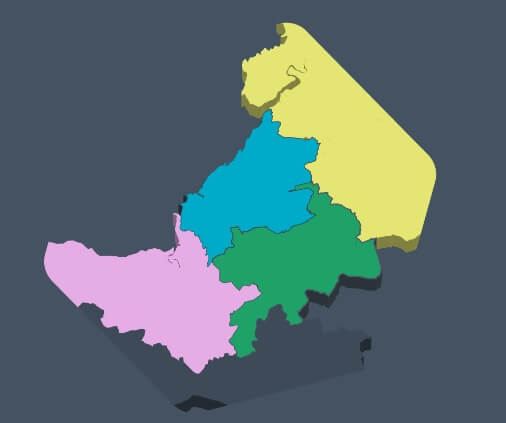
Which county is Bristol in?

Famous for its historical use as a dockside port during the age of mercantilism, eclectic music scene, International Balloon Fiesta, amongst other roles and events, Bristol is a metropolitan city filled to the brim with character and diverse culture – as well as the home of Associated Windows. The city features a population of around half a million and remains a prevalent destination for tourists worldwide, yet one issue that continues to plague, even locals, is exactly which county Bristol comes under.
It’s time to set the record straight once and for all!
Bristol is its own county, first and foremost
Yes, that’s right. Simply put, since 1373 Bristol has always been a county in its own right, with its formal and legally recognised title being the “City and County of Bristol”. The common confusion and most alternate theories often arise due to the differences between what classifies a city, county, and the lesser known unitary authority. For some, it can seem strange for one area to be designated as two of these or all three, when for Bristol this is absolutely the case.
A brief history of events – Originally founded and named around 1000 AD, what would later become known as Bristol garnered a reputation for being a significant port by the 11th century. It was during this time where the area played a vital role in the trade of slaves and goods, mainly with Ireland, before expanding what little-defined boundaries there were to eventually receive county status from King Edward III in 1373.
Trade continued to be a booster for Bristol going into the Tudor and Stuart periods, finally being classified as a city in 1542. Well over 150 years after it had already secured county status, this came about largely due to Henry VIII’s dissolution of the monasteries. Today, Bristol remains both a city and a county in and of itself, falling neatly in between Somerset and Gloucestershire.
All things considered, it shouldn’t come as too much of a surprise to learn that something as simple as the county Bristol resides in can cause a stir. After all, merely asking the name of Bristol’s local football team requires an equally awkward explanation. Regardless of whether you support Bristol Rovers or Bristol City, now you can rest comfortably knowing that Bristol has, for the most part, and still is its own county.
Bristol’s usual suspects: Avon, Somerset, Gloucestershire
If you were to ask any average Bristolian which county they believed Bristol to be based in, they’d likely come out with one of three answers: Avon, Somerset, Gloucestershire. In a way, Bristol brought this confusion upon itself, with many residents based in the city between 1974 and 1996 quick to assume that Avon is the correct answer.
Funny thing is, that if asked during this time they’d be right!
Named after the tidal river which flows through the city, in 1974 the county of Avon was founded with the hope of simplifying local government structuring. The reorganisation stemmed from an idea which was originally floated around by a boundaries commission in 1887. It continued to be contested right up until the 1972 Local Government Act came into effect, allowing the county to be formally created in 1974.
Areas included under the Avon county banner included the boroughs of Bristol and Bath, certain areas of Weston-super-Mare, Clevedon and Keynsham’s urban districts, and so on. If you hadn’t already guessed, the so-called “one-tier county” was complex and turned out to be more trouble than it was worth. And though remedied with Avon’s abolishment in 1996, the damage had already been done, with many local institutions taking on the Avon moniker, and keeping it to this day.
Public bodies retaining the Avon title includes facilities as fundamental as the city’s emergency services – Avon Fire and Rescue Service. And though not directly a cause for concern, seeing this title plastered on most of the county’s fire engines could prove to be one of the most responsible reasons that mass confusion over Bristol’s county still goes on today.
Similarly, Somerset and Gloucestershire occasionally crop up as substitutes for Bristol’s county, most likely due to the nation’s tendency to associate the West Country as a collective due to the distinct dialect. However, both are distinctly separate counties with Bristol sandwiched in between.
Will Bristol always stand on its own as a county?
Though nothing solid is in place, the recent election of various metro mayors in the area means there’s talk of Bristol possibly expanding to form “Greater Bristol”. Current Bristol mayor Marvin Rees disputes these claims however, expressing that he’s considering a re-brand for the region but that Avon as a county is very unlikely to return under his watch. Reunifying old pieces of former Avon would be a tough task to say the least, and could result in even more confusion about Bristol’s county.
Of course, merging counties in this way would have no impact on the affected areas’ city statuses, but could perhaps put constituents like North Somerset, Bath, and yes, Bristol at risk of losing more of their local identity and sense of place. Rees admits that there have been, and currently still are, historical challenges to overcome when attempting to pinpoint the differences between the West of England, the West Country, and the South West.
Reuniting Bristol with its neighbouring counties would mean tipping the county’s population to well over a million, with the theory behind doing so would be to give “Greater Bristol” more economic and political authority when compared to its fellow metropolitan cities. Take the proposed 12,000-capacity arena that continues to have trouble getting off the ground, for example. Should an Avon-like county indeed reform, funding for such an ambitious project would be managed by one authority rather than several, but would run the risk of muddying the waters.
For the foreseeable future, Bristol will seemingly operate as a county all on its own, as certain political parties in and around it continue to fight against any further regional changes. The term “Greater Bristol” is sometimes used as a catchall pseudonym for the locales which surround Bristol, but as it stands it isn’t an official title.
Bristol identity vs Place
Outside of common county misconceptions, it’s fair to say that this minor hiccup doesn’t affect Bristol’s reputation as one of the UK’s most thriving areas to explore and live in. Most locals will never even feel the need to dwell on the issue, believing in the strength of community more so than artificial boundaries which do very little to affect day-to-day life.
To be Bristolian is to be proud of the eclectic mixture of sights to see and diverse art to experience, whether that be in the thick of Bristol’s central hub Broadmead, or the slighter more gentrified areas like Clifton and Long Ashton. The maritime aspect runs through the city’s veins, it of course being the home to Isambard Kingdom Brunel’s SS Great Britain and Suspension Bridge, and the city’s reputation as the home of renowned experimental artist Banksy continues to inspire others.
Foodies will also find plenty to enjoy as Bristol has quickly earned the unofficial title of “Burger capital of the UK” – a moniker most people will have trouble taking issue with compared to history’s Avon. The point being that there’s so much to the city, much like any other, when not bogging yourself down with which county it may or may not be a part of. It has topped “Best places to live in the UK” lists numerous times, in lists that don’t just poll landmarks and such, but assess crime rates, school performances, and house prices too.
Bristol’s identity and place are intertwined in that neither can exist without the other. Regardless of county, this will always be the case!
Back to news












